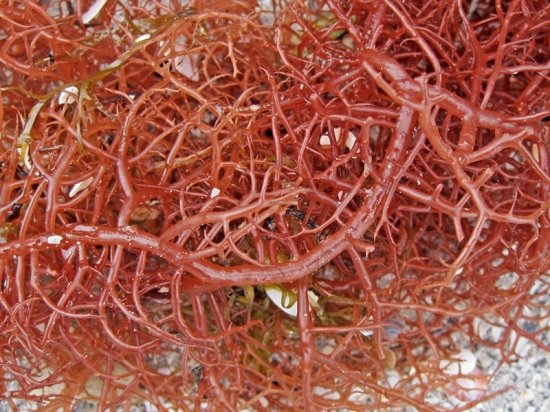Gracileria: Sustainability of Cultivation and the Production Process of Agar
In my critique, a question was raised about the sustainability of cultivating and harvesting red algae for agar production.
Gracilaria (figure A) is a red algae which is most commonly used in the production of agar, and cultivation is widespread in coastal waters around the world, including countries such as Argentina, Chile, China, the Republic of Korea, Indonesia, Namibia, the Philippines and Viet Nam. Gracilaria plays an important role in marine ecosytems and is a source of food for many marine animals. The derivative, agar, is used as a stabilizing, thickening and gelling agent in the food industry, microbiology, biotechnology, pharmaceuticals, dentistry etc.
Gracilaria is easy to propogate, has a high growth rate and high tolerance to varying salinity levels. The common methods for growing Gracilaria for commercial harvesting are in open waters (on the bottom of bays, estuaries or reef flats), in ponds, or in indoor tanks. It is grown on ropes, lines or nets. Figure B shows images of cultivation and harvesting, This seaweed grows fairly rapidly, about 16% in a day. A piece about the size if a fist will grow to the size of a soccer ball within 21 days. As a natural resource it is easily grown in abundance.
The agar produced from the Gracileria is sold in flake, powder, bar, and strand form, examples are shown in figure C. I have used the powder and these have varied in colour (white to yellowish) and the strengths of the gels created have varied. I have recently ordered 5kg of Agar 1200 powder from a supplier in China. This powder creates the strongest gel so I am hoping it will be useful for creating sturdier skins which I can manipulate for art forms.
I did further research on the environmental impact of agar production a process shown in figure D. A 2018 publication of The Italian Association of Chemical Engineering, Environmental Evaluation of Agar Production, by Chemical Engineering Transactions who researched the environmental impact generated by the production process and concludes (see figure E) that the production of agar is an ‘environmentally friendly process’ and has no significant effect in regards to ecological impacts on land, water systems nor is production detrimental to the atmosphere. The cultivation of Gracileria and other seaweeds creates underwater forests which purify water and absorb carbon, nitrogen and phosphorus which makes it beneficial to mitigate effects of climate change. The photosynthesis process of the varies algae’s in the ocean (macro and micro species) produce around 70% of oxygen in the Earths atmosphere. Cultivation and harvesting supports economies by providing employment and revenue sources.
From research undertaken, the cultivation and production of Agar seems to be a positive and environmentally friendly process, although awareness of greenwashing and that different farms may adopt methods which perhaps are not as environmentally friendly as others.
Figure D. Gracileria to Agar Production Process
Source: https://doi.org/10.3303/cet1870335.
Figure E. Screenshot of excerpt from Environmental Evaluation of Agar Production from Macroalgae Gracilaria sp.
Source: https://doi.org/10.3303/cet1870335.
Resources & References
Cassiani-Cassiani, Daylisney, Demmy A. Meza-González, and Ángel Darío González-Delgado. 2018. “Environmental Evaluation of Agar Production from Macroalgae Gracilaria Sp.” DOAJ (DOAJ: Directory of Open Access Journals), August. https://doi.org/10.3303/cet1870335.
“Gracilaria Cultivation.” 2023. Algae Technology Educational Consortium [ SFCCATEC]. Accessed September 14, 2023. https://www.youtube.com/watch?v=FuLUWJQW8z8.
“Gracilaria Sp.” 2023. Alganex. 2023. Accessed September 19, 2023. https://alganex.com/en_US/products/gracilaria-sp.
McHugh, Dennis J. 2003. A Guide to the Seaweed Industry. Food and Agriculture Organisation of the United Nations. https://www.fao.org/3/y4765e/y4765e00.htm#Contents.
Mendes, Madalena, Duarte Fortunato, João Cotas, Diana Pacheco, Tiago Morais, and Leonel Pereira. 2022. “Agar Content of Estuarine Seaweed Gracilaria Using Different Cultivation Methods.” Applied Food Research 2 (2): 100209. https://doi.org/10.1016/j.afres.2022.100209.
Sambhwani, K., Kazi, M.A., Mantri, V.A. (2022). Gracilaria: An Emerging Source of Agar Feedstock—With Special Reference to Industrially Important Species. In: Ranga Rao, A., Ravishankar, G.A. (eds) Sustainable Global Resources of Seaweeds Volume 2. Springer, Cham. https://doi.org/10.1007/978-3-030-92174-3_2
Figure A. Gracilaria sp.
Source: https://alganex.com/en_US/products/gracilaria-sp
Figure B. Gracilaria Farming and Harvesting
Source Gracilaria: An Emerging Source of Agar Feedstock—With Special Reference to Industrially Important Species https://link.springer.com/chapter/10.1007/978-3-030-92174-3_2#citeas
Figure C. Agar Powder and Bars
Source: https://www.thespruceeats.com/what-is-agar-agar-p2-1000960





